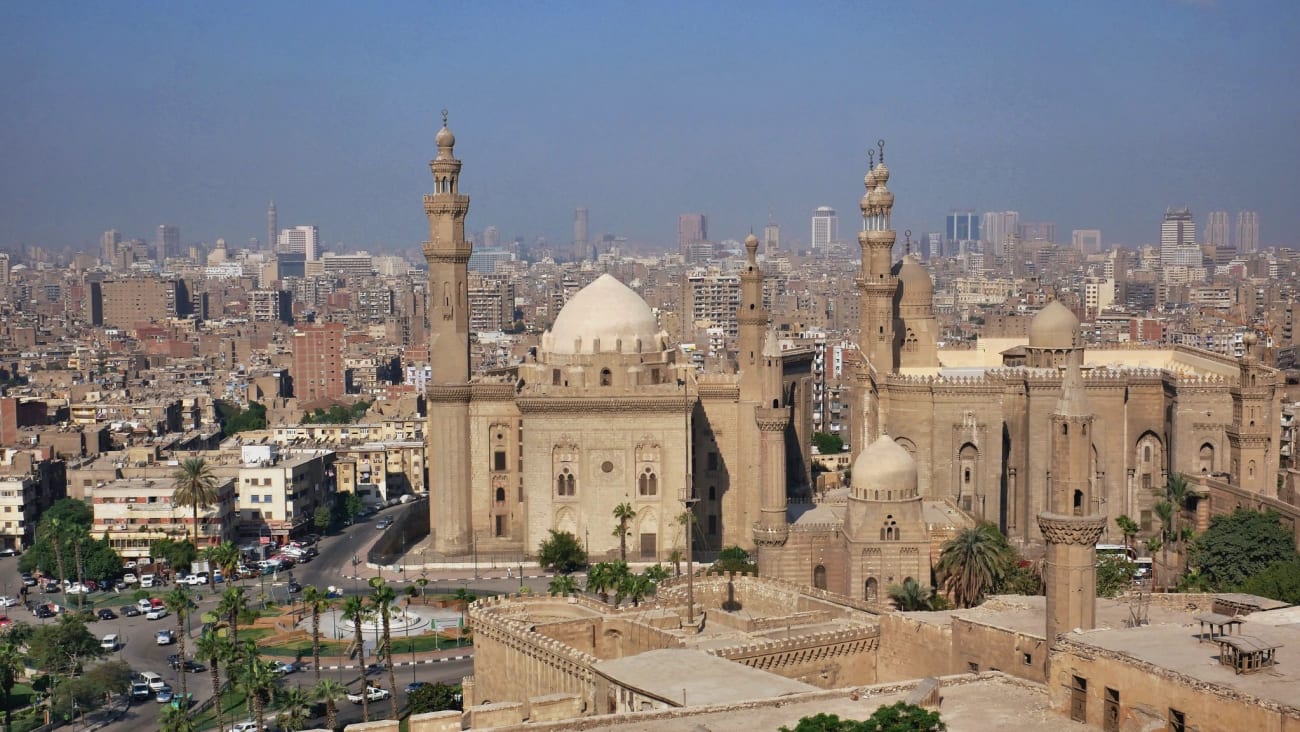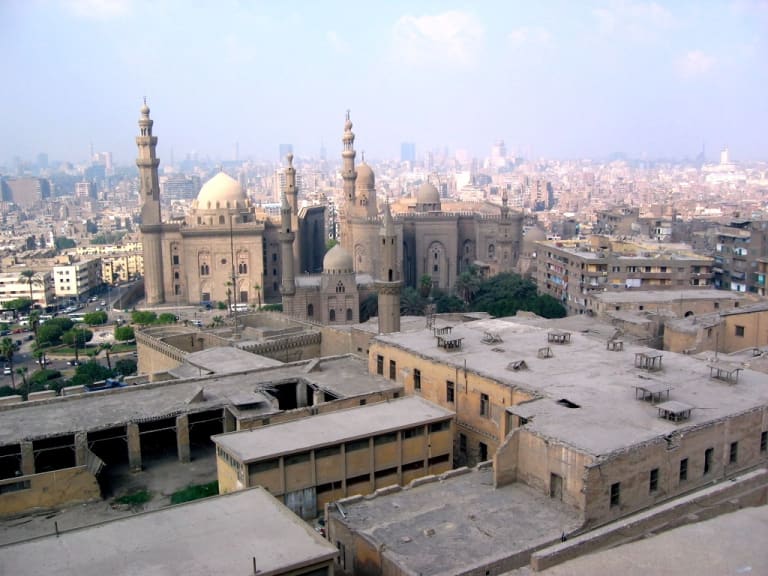Things to Do in Cairo Citadel
Don't forget to visit the home of 3 historic mosques and 4 museums with a lot to tell - a small historic town in every sense of the word!

View from the Citadel | ©Airton Morassi
Very few places in the world show a clear vision of the Islamic fortress of the past as does the Saladin Citadel, located southeast of the city of Cairo. In this UNESCO World Heritage area you can visit the famous Muhammad Ali Mosque and Al-Nasir Muhammad Mosque.
You will also have the opportunity to visit museums and viewpoints that will leave you amazed by the views they offer. The entrance fee is almost 6 euros, and that will be the only thing you will pay to visit all that this small walled city rich in history has to offer.
Muhammad Ali Mosque

The main reason most people come to see the Cairo Citadel is the Muhammad Ali Mosque. Commissioned by Muhammad Ali Pasha between 1830 and 1848, this spectacular mosque was built to rival the Hagia Sophia in Istanbul.It is also known as the ** Alabaster Mosque** as the lower floor and esplanade are tiled with alabaster up to 11.3 meters (the rest is limestone).
Don't forget that there is a clock in the mosque's courtyard, much like the one in Place de la Concorde in Paris. You definitely shouldn't overlook the giant chandelier hanging from the domed ceiling of the Mohammed Ali Mosque. Due to frequent sandstorms, everything is a bit dusty, still interesting to see.
Viewpoint of the Muhammad Ali Mosque
You should take some time to explore the large terrace at the front of the mosque. It is by far the best viewpoint in Cairo. The Sultan Hassan Mosque-Madrassa and Islamic Cairo can be seen looking down, while cruise ships passing by on the Nile and downtown Cairo come into view on the horizon. On a clear day, you can even see the Great Pyramid of Giza Doesn't that sound impressive?
Note: Remember to enter this mosque (like any other mosque) without shoes. Socks are allowed and you can enter for free even if you are not Muslim.
- Opening hours:Everyday from 9:30am to 4:00pm
- Entrance fee:Included in the general entrance fee to the Citadel.
2. Al-Nasir Muhammad Mosque

The mosque of Sultan al-Nasir Muhammad ibn Qala'un is the true jewel within the citadel of Cairo. Built in the early 14th century, the magnificent hypostyle mosque impresses with its serene courtyard and the two ancient minarets.
The mosque is quite peculiar, as its two minarets are quite ornate, unlike any other minarets of the Mamluk period. No other mosque in Cairo is decorated with mosaics.
Originally built for Sultan al-Nasir for his daily prayer, it ceased to play a prominent role in the daily life of the kings long before the British conquest. The Ottomans had looted the beautiful building, and it was an amateur archaeologist named C.M. Watson who restored the beautiful mosque to its former glory.
- Hours ofoperation:Everyday from 9:30am to 4:00pm
- Entrance fee:Included in the general entrance fee to the Citadel.
3. Gawhara Palace

El Gawhara Palace is located in the southern section of the Saladin Citadel and is accessed through the museum entrance which is opposite the main entrance of the magnificent Mohammed Ali Mosque. Today, it has been converted into a museum, although it does not have many exhibits; it is admirable for its wonderful architectural elements, elegant decorations and the incredible furniture that was used by Mohamed Ali and his royal family.
The Gawhara Palace was built following a distinctive style of architecture that was probably a mix between the Ottoman style and the European style of palace architecture. The Ottomans knew how to build palaces, if you were lucky enough to visit the Top Kapi and Dolmabach palaces inIstanbul you will know how incredibly professional the Ottoman architects were.
The most important section of the Gawhara Palace is the main hall or what they used to call "The High Council of Mohammed Ali", as this is where the main decisions used to be made. The exhibits of the Gawhara Palace include many royal paintings, costumes and clothing, furniture and many other interesting exhibits that will capture your attention as soon as you enter the palace.
- Opening hours:Everyday from 9:30am to 4:00pm
- Entrance fee:Included in the general entrance fee to the Citadel.
4. Police Museum

The first passageway of the Police Museum displays some portraits of the interior ministers who played an important role throughout Egyptian history. There are some photos of the ministers from the early 20th century to the most recent.
The first exhibition hall in the Police Museum houses a number of weapons that were used by the Egyptian police at different times in the country's history. This includes a large wooden stick that was used as a shield during the Pharaonic period.
The exhibits in this room include a large collection of modern weapons such as pistols and that were mainly manufactured by the British during their occupation in the early 20th century.
The Police Museum in the Citadel was officially opened in 1984, as the building was a military prison in the Citadel until it was transformed into a museum thanks to a decree by former Egyptian President Hosni Mubarak. For more information visit the following website.
- Opening hours:Everyday from 9:30am to 4:30pm
- Admission fee:Included in the general entrance fee to the Citadel.
5. Egyptian Military Museum

The outer entrance door of the military museum at the Citadel opens onto a well-kept garden. The inner and main door of the museum leads to a display of tools that were used by the soldiers, in addition to a number of weapons and some of the Israeli tanks that were used during the October 1973 war.
At the end of the hallway, there is a large circular arena with the famous statue of Ibrahim Pasha, the leader of the Egyptian army during the reign of Mohamed Ali, standing in the center. Then, there is another wide passageway that houses some statues of the king and rulers of Egypt during the Pharaonic era such as Ramses II and King Menes, the Unifier of southern and northern Egypt. In front of these statues, there are other statues of more modern rulers of Egypt such as Saladin Al Ayouby, Al Zaher Beybars, Mohamed Ali and Khedive Ismail.
I recommend you to go up to the 3rd floor of the Military Museum as it has many exhibits illustrating the history of the Egyptian military forces during the Islamic era. For more information visit the following website.
- Hours of operation:Every day from 9:30 a.m. to 4:30 p.m.
- Admission fee:Included in the general entrance fee to the Citadel.
6. Sultan Hassan Mosque

The building is about 500 meters long, 68 meters wide and 36 meters high. Like all mosques, it is oriented towards Mecca and is located southeast of Cairo. The mosque is huge, occupying almost 8000 square meters and is very close to the entrance of the Cairo Citadel. It stands near a luxurious palace that had previously been built at great expense by Hasan's father, Sultan al-Nasir Muhammad, for one of his amirs, Jalbugha al-Yahawi, and which was demolished to make way for the mosque.
The building is a massive example of Mamluk architecture, built during the 14th century reign of a sultan who was famous for his extravagant spending. I am sure you will be impressed by its imposing and beautiful architecture.
The Sultan Hassan Mosque is one of the most valuable monuments in the Islamic world. Just as the pyramids of Giza are a symbol of ancient Pharaonic Egypt, the Sultan Hassan Mosque is that of ancient Islamic Egypt. The mosque is open and available for visitation every day without interruption.
- Opening hours:Every day from 9:30 a.m. to 4:30 p.m.
- Entrance fee:Included in the general entrance fee to the Citadel.
7. Viewpoint of the Citadel

Another point of interest is the viewpoint, which, despite being on the terrace of the police museum, deserves special mention. Many tourists skip the visit to the museum and go directly to the viewpoint from where you can see the entire Citadel and the skyline with an impressive quality. The place is free access and is located on the terrace of the police museum. On a day without fog or sand movements, the Pyramids of Giza can be appreciated with modest precision.
- Hours of operation:Every day from 9:30 a.m. to 4:30 p.m.
- Entrance fee:Included in the general entrance fee to the Citadel.
8. Mosque of Ibn Tulun

Ibn Tulun is the oldest surviving mosque in Cairo, and one of those underrated religious buildings in Cairo, despite being an architectural masterpiece completed in 879 AD.
Although the mosque is not as ostentatious as some of the mosques in Istanbul, for example, it is not devoid of ornamentation; however, what makes it stand out the most is that it is built with red brick and has rough textured walls filled with designs related to Arab and Muslim art. If you walk through the arcades, you will notice the underside of the arches decorated with geometric patterns carved in stucco, each one different from the next.
- Hoursof operation:Every day from 9:30 a.m. to 4:30 p.m.
- Admission fee:Included in the general admission to the Citadel.
9. The Gate or Bab El-Azab

Bab El-Azab is the monumental gate of the Citadel of Cairo, this gate overlooks the Salad el Din Square. In the past it protected the original entrance of the citadel, this gate was rebuilt in the year 1754, just when the wooden doors were added.
The gate is very famous for witnessing several anecdotes linking the governor Mohamad Ali to the power and the Mamluks (warriors, mostly of Slavic, Circassian and mainly Turkish origin, Islamized and militarily instructed).
A few meters from this gate you can see the ** Mausoleum of Qansuh Abu Said** established. Across the street from this mausoleum is Zawiyat Hasan El-Rumy, an ordinary and beautifully decorated building dating from 1522.
- Hoursof operation:Every day from 9:30 a.m. to 4:30 p.m.
- Entrance fee:Included in the general entrance fee to the Citadel.
10. Burg El Hadid and Burg El Ramla - The two most important towers of the Citadel

Burg El Ramla and Burg El Hadid ,or the sand tower and the iron tower, are located in the Citadel of Saladin in Salah Salem.They are located towards the north of the Archaeological Garden Museum and along the city walls. These towers were established by El Adel, the son of Salah El Din and his successor.
They were added as part of the restoration of the citadel to strengthen the original towers of the northern enclosure in 1207. These towers will allow you to enjoy an overview of all the monuments in and around the Citadel, including the Northern Cemetery and the Sultan Hasan Mosque, one of the finest mosques in Cairo.
- Hoursof operation:Every day from 9:30 a.m. to 4:30 p.m.
- Entrance fee:Included in the general entrance fee to the Citadel.
Entrance fee to the Citadel of Cairo

The entrance fee to the Cairo Citadel is 100 Egyptian pounds (LE) per person (5.75 euros). Tickets can be purchased only at the entrance. There is a security checkpoint just after the entrance. There is no need to buy tickets in advance or go through a travel agency.
Opening hours of the Cairo Citadel

The Cairo Citadel is open Monday through Sunday from 9 am to 5 pm daily.
Please note that the Citadel closes at 3 pm during Ramadan. Also, it is best not to visit on Fridays, as the Muhammad Ali Mosque will be quite busy on these days. You should probably also stay away from the midday heat, especially if you visit Cairo in summer (especially in July and August), as the Citadel in that season turns into a real oven.
How to get to the Cairo Citadel

The Cairo Citadel has three remaining gates, but only the Bab Al-Gebel gate will take you inside. There is a large parking lot in front of it (you have to walk a short distance up a hill from there). It is reached via Salah Salem Street which winds around the Citadel hill.
Basically, the only feasible way to get there is to take a cab. There is no metro station nearby (we are talking about 5 kilometers !). I also don't recommend walking from the Sultan Hassan Mosque-Madrassa, as you will still have to continue walking for about 2 kilometers.
The only other viable alternative is to book a bus tour of Islamic Cairo that will also stop at the Citadel. If you don't mind walking in a group, this is probably the cheapest alternative. Although Egypt is safe in most tourist areas,I understand that many tourists simply do not feel comfortable hiring a cab, if this is your case, you have no choice but to opt for renting a car or going on an excursion from Cairo.
Tips for visiting the Saladin Citadel

Keep these tips in mind when visiting the Saladin Citadel. Although they are general tips they are almost essential when visiting this magical historical site.
-The Citadel is open from 8am to 5pm-The entrance fee is charged, check herefor themost up to date prices -Near the Mohammed An Nasir Mosque there are free toilets, although the workers expect a small tip, so you should bring coins or small bills for tips -In the mosques it is mandatory to enter barefoot.
